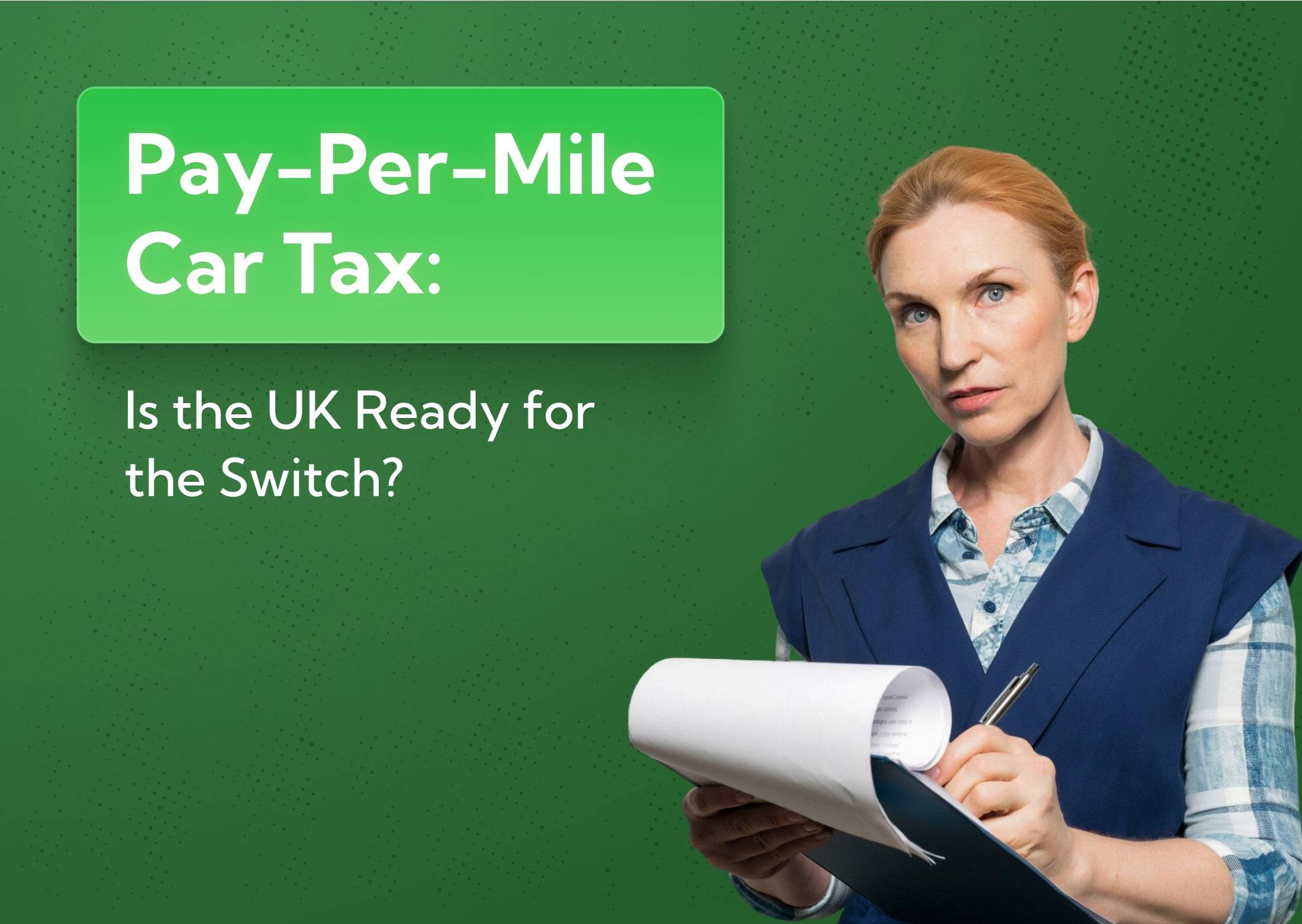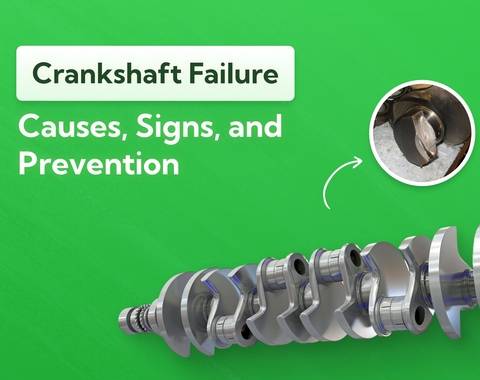Pay-Per-Mile Car Tax: Is the UK Ready for the Switch?
Talk of a new pay-per-mile car tax system is growing. However, how close are we, really? In this guide, we’re exploring what a pay-per-mile system is, the different models available, the pros, the cons, and what we can learn from pay-per-mile pilot schemes overseas. Is the UK ready for a whole new road tax approach? Let’s find out.
Last updated: 23rd October, 2025

Award-winning CEO driving growth and social impact across automotive, recycling, and technology-led enterprise platforms.

Listen to this story
2025’s car tax hikes indicate a problem: with growing adoption of zero and low-emission vehicles, road tax income is plummeting. If we’re going to keep our roads in good shape, the government’s going to need to rethink VED.
So far, a major overhaul is no more than a whisper on the air. The government has no official plans to implement any big changes. However, there’s rumour they’re considering it.
The alternative to VED would be a pay-per-mile car tax system, sometimes called “road pricing”. Some say it’s the way forward, others say it would mean big tax hikes. But what’s the truth?
Let’s explore everything we know about pay-per-mile car tax and see whether it could work on Britain’s roads!
What's in this article
- 1. Introduction to Pay-Per-Mile Car Tax
- 2. Why Pay-Per-Mile Tax Is Being Considered
- 3. How Pay-Per-Mile Car Tax Could Work in Practice
- 4. Potential Benefits of Pay-Per-Mile Car Tax
Introduction to Pay-Per-Mile Car Tax
A pay-per-mile car tax system is where vehicles pay a rate (flat or variable) based on how many miles they drive. Essentially, it shifts the focus from emissions to road usage; the more you use the road, the more you pay, whatever your vehicle type.
That makes it very different from the current VED system. In this system, most vehicles pay based on how much CO2 they emit, regardless of how much they actually use the vehicle or public roads.
So, why is the government considering such a massive change? Well, our current car tax system has a problem. Zero and low-emission vehicles like EVs are becoming more and more popular. Although the government wants to encourage this as we hurtle towards Net Zero, that also means road tax income has dropped (as EVs didn’t, until 2025, pay VED).
Although EV owners will now have to pay car tax like everyone else, tax income simply isn’t enough to keep up with road needs.
Proponents say a pay-per-mile car tax system could offset this.
Why Pay-Per-Mile Tax Is Being Considered
Discussion around a new road tax system is nothing new. It’s been floated around for over a decade now, since the Institute for Fiscal Studies (IFS) first suggested it. Since then, support has only grown.
Although the government is resisting it, major think tanks and institutions are backing pay-per-mile car tax. The Tony Blair Institute for Global Change and the Campaign for Better Transport both see it as the future, and the National Infrastructure Commission chairman Sir John Armitt has called pay-per-mile road pricing “inevitable”.
Overall, major contenders pushing for a new type of road tax model share motivations: they say the traditional revenue streams are finished (current VED could lose £19b by 2029) and the current system can’t keep up with rapidly rising congestion and infrastructure needs.
In short: there’s a lot of pressure, but the government is reluctant to go ahead as public opinion is still very much against pay-per-mile taxation.
Let’s learn more about what pay-per-mile would actually look like:
How Pay-Per-Mile Car Tax Could Work in Practice
Although it might sound like a simple concept, there’s no single pay-per-mile car tax system being proposed. There are multiple ways it could work, with different proponents touting the advantages of each.
Some of the most commonly favoured models include:
- GPS tracking vs mileage reporting - some believe we should simply track mileage with a dedicated telematics unit or smartphone app, while others say reporting mileage at MOTs or tax renewals, for example, would be better. People often say GPS tracking would be more accurate but more invasive; mileage reporting is less accurate but perhaps more privacy-sensitive.
Flat-rate vs variable pricing - the government could either choose a simple “one pence-per-mile” model for all private cars, which would be extremely easy to administer and communicate. However, some say that doesn’t take into account external costs like congestion and pollution.
Many UK proposals explicitly state a preference for tiered pricing, where the tax you pay per mile is based on the type of vehicle you’re driving. This could make it fairer.
- Integration with DVLA, MOT and insurance databases - in a pay-per-mile system, different databases would be more integrated. We could either link DVLA and MOT/garage systems so odometer readings are pushed into the system, reconcile mileage submitted directly by the telematics provider, or even use insurers’ data to verify mileage or to offer integrated billing.
All of these ideas have their pros and cons. One of the biggest general concerns with all of these pay-per-mile car tax systems revolves around privacy and data protection. Critics often state that constant, detailed movement tracking would breach privacy rights and even create an attractive target for hackers.
However, proponents believe we could create strong systems that could keep data safe.
Potential Benefits of Pay-Per-Mile Car Tax
Despite the concerns around privacy, advocates for pay-per-mile car tax changes put up a good fight. They cite a huge swather of potential benefits to this new model, including:
Fairer System for Low-Mileage Drivers
Instead of paying a fixed £100+ car tax rate for drivers who only use their vehicles occasionally (or don’t go far in them), a pay-per-mile system could dramatically reduce how much they pay.
Let’s take an example. The Tony Blair Institute for Global Change proposes a 1p-per-mile introductory rate. For an average driver (who drives around 7,000 miles), that would work out at about £70 per year. However, for someone who drives far fewer miles, say just 2,000, it could cost as little as £20. Depending on your car, that could save well over £100 a year.
It’s also fairer in the sense that low-mileage drivers use the road less, so should, according to this logic, pay less for road maintenance.
Encouraging Greener Travel Choices
Many UK drivers stack up a lot of miles using their vehicles for countless short-distance trips. With a pay-per-mile system, they could end up paying more than their current rate.
If there’s a valid option for efficient, affordable public transport, travellers might opt for that instead. This would be beneficial not just for their wallets, but for the environment, too.
In short, pay-per-mile car tax changes could encourage everyday drivers to think more about whether they’re willing to pay to use their cars.
Better Funding for Road Infrastructure
There’s no exact number to work with as the government doesn’t have any official plans for pay-per-mile car tax. However, some proposals lay out plans to introduce a charge of as much as 15p-per-mile (depending on the vehicle type).
That would work out at £1,050 for an average 7,000-mile year. That’s a huge increase from the current standard rate of £195. The government could use this money to plug the estimated £40b VED black hole that will exist by 2030.
Such an increase in funding could be spent on much-needed new roads and more efficient road repair systems.
Flexibility for Future Transport Trends
Driving habits are changing. More and more people are using shared mobility and driving electric vehicles. However, this is forcing VED income down. The proposed pay-per-mile car tax changes aim to address these challenges.
For a start, a fairer road pricing system would mean that all drivers, including those with zero-emission vehicles, would contribute to road maintenance.
Then, we can consider shared mobility. Currently, it’s very hard to track fairness between private ownership, ride-hail fleets, and car clubs. A new model could level the playing field.
Lastly, the pay-per-mile model actually could address congestion and air quality concerns, despite critics saying it couldn’t. For example, it might be possible to implement zonal/dynamic rates in real time - higher per-mile in city centres at rush hour, zero-rate in rural areas.
Challenges and Risks of Pay-Per-Mile Car Tax
Commonly cited benefits may make pay-per-mile car tax seem like a perfect solution. However, if it was perfect, we would already have implemented it. Pay-per-mile is not universally popular - in fact, one study found that 61% of British drivers are opposed to it. Nor would it be easy to implement.
Cost of Implementing a Nationwide System
Rolling out a nationwide pay-per-mile scheme would be enormously expensive and complex.
Firstly, the government would need to develop a watertight GPS-based system. If it had any hope of working, this would require:
- Telematics hardware or smartphone apps
- Secure billing platforms
- Integration with DVLA, MOT, and insurance databases
Even an odometer-based approach would need significant upgrades to verification processes to prevent fraud.
There aren’t any reliable figures out right now, but it’s widely believed an initial setup cost could easily run into the billions of pounds. That doesn’t even include aspects like:
- Ongoing maintenance
- Enforcement
- Auditing
Resistance From UK Drivers
One of the biggest hurdles is public acceptance, of course. Surveys generally suggest that most drivers are against pay-per-mile car tax changes, at least when it’s called “road pricing”. Many believe it will simply lead to higher costs and unfairness.
Likewise, many see it as yet another tax on motorists simply being used to round up more cash quickly. That’s not to mention the privacy concerns.
Building trust will require careful framing, transparency, and possibly revenue-neutral commitments (e.g., offsetting reductions in VED or fuel duty).
Risks of Over-Surveillance and Tracking
How do you feel about having a live GPS tracker in your vehicle at all times? For some, it’s a step too far. The simple fact is that this raw location data can reveal a lot: home addresses, work patterns, personal routines - you name it. The government is currently facing similar backlash to their Online Safety Act. The last thing they want is more “Big Brother” criticism.
In response, the Information Commissioner’s Office (ICO) has stressed that data protection by design would be essential. Even so, public fears of misuse could undermine legitimacy and pose a huge barrier.
Inequality for Rural vs Urban Drivers
A flat per-mile tax may look fair at a glance, but doesn’t always hold up under scrutiny. Take rural drivers, for instance. They often have to drive farther out of necessity and often lack the public transport alternatives needed to minimise this. A flat rate would hit them unfairly.
On the other hand, urban drivers might also face additional charges if congestion or clean-air surcharges are layered onto the system (neither of which is their fault).
Unless carefully designed, pay-per-mile could exacerbate geographic inequality, effectively taxing rural living more heavily.
However, advocates have gone some way to addressing these concerns. They’ve suggested such mitigations as:
- Tiered rates
- Mileage allowances
- Targeted rebates or exemptions
Lessons From Other Countries Testing Pay-Per-Mile
Luckily, we don’t have to rely on guesswork and estimates to get an idea of how a pay-per-mile car tax system could work. Other states and countries have already implemented, or at least piloted road pricing schemes. If we’re smart, we can learn from these experiences.
Let’s take a look at the most significant road pricing tests to date:
US State Pilot Programs (Oregon, Utah, etc.)
There have been several significant pay-per-mile pilots in the US. The two most prominent are in Oregon and Utah.
- Oregon - Oregon launched OReGO all the way back in 2015. It’s an effective pay-per-mile charge that offers multiple reporting options (like (in-vehicle devices or simple odometer reporting). Notably, they also use “account managers” to handle billing. The system is mostly voluntary but has seen some success.
- Utah - Utah is trialing a similar Road Usage Charge (RUC) for EV drivers. The RUC integrates tolling and RUC pilots to test payment simplicity and cost reductions. Utah emphasises voluntary enrolment and multiple tech options, just like OReGO does.
What can we learn from these pilots? Firstly, choice is important: drivers want to be able to use a low-tech odometer option if they desire. Secondly, transparency: Oregon’s private account manager system keeps drivers feeling secure. Any UK system would do well to take note!
European Approaches to Road Pricing
Europe is a patchwork of tax systems, including:
- Heavy-vehicle GNSS tolling
- National/urban congestion charges
- Vignette/toll systems for long-distance networks
Norway stands out as an example of a country that’s actively pursuing a distance-based pricing system. The government there says it’s about equity and home-zone protection.
No European country has fully implemented pay-per-mile car tax changes, so it’s hard to gauge success. However, we can see from similar pilots that acceptability tends to rise after implementation, not before. This is called the “familiarity effect”. Transparency about revenue is also key.
What the experts say

Anthony Sharkey
What the UK Can Learn From Early Trials
We can boil the top lessons from ongoing pay-per-mile car tax trials down into a few super-important lessons:
- Offer choice & low-barrier options - the US experience shows that people prefer odometer-based reporting in general, so the UK should avoid implementing a strict GPS-based telematics system from day one.
- Use pilots to test operations - pilots let people get familiar with road pricing and have the added benefit of helping operators identify and address any specific problems before scaling the system.
- Design for equity - any UK pay-per-mile car tax system should consider aspects like mileage allowances and targeted rebates to reduce pushback.
- Keep data-privacy front and centre - overseas pilots show that drivers may accept road pricing as long as their data is handled with care. Transparency and independent audits are always a good idea.
Is the UK Ready for the Switch?
Surveys suggest the majority of Britons are currently opposed to pay-per-mile car tax changes. However, evidence from pilots in the US and Europe suggest that drivers often become more favourable towards road pricing once it’s implemented, even in spite of pre-launch opposition. The key aspect is choice in terms of how miles are tracked.
Whatever happens, the UK needs to adjust its road tax system soon. The government is on track to lose billions of pounds in VED revenue in the coming years - money that’s essential for road maintenance and upkeep.
UK drivers might not feel ready just yet, but we won’t know until we try. The government’s best immediate option is to roll out a pilot scheme in a limited area and gather data.
Alternatives to Pay-Per-Mile Car Tax
A change is needed. The country needs more money for its roads. If the government doesn’t go for a pay-per-mile car tax system, what other options does it have?
Here are a few:
Increased Fuel Duty on Petrol and Diesel Cars
The most obvious alternative to a total car tax system overhaul is to simply increase the current fuel duty rates. That would be tough. There’s been a long-standing freeze on fuel duty, and drivers would likely not appreciate a serious rise in rates.
This approach would also fail to address the main problem: lost revenue from EVs. You can’t implement a fair, tiered fuel duty on vehicles which produce no emissions; you’d have to increase the standard rate.
However, increasing fuel duty would be the simplest, and perhaps the most likely, alternative to full tax system reform.
Higher Flat Vehicle Excise Duty Rates
One option, similar to increasing fuel duty, would be to simply increase flat-rate VED across all vehicle types. The government could even redesign the VED system to focus on weight or value rather than simply emissions. The DVLA already collects VED, so this approach would be relatively straightforward to implement.
However, a flat-rate rise fails to reflect actual road use. A low-mileage pensioner would pay the same as a high-mileage commuter. It also does little to discourage congestion or unnecessary trips, making it a blunt instrument for managing traffic demand.
Road Tolls and Congestion Charging
Drivers in parts of the country are already used to road tolls and congestion charges (like the London Congestion Charge or the Dartford Crossing tolls). These have been effective in reducing congestion and pollution in targeted areas. Plus, authorities can, if they want, ring-fence revenue for local needs.
However, a nationwide model based on tolls could be extremely confusing and complicated. It might, for instance, leave large gaps in rural areas, and make it hard to create a consistent national revenue stream.
There are also several major operational costs involved in such a system.
Hybrid Models Combining Different Tax Systems
The government doesn’t have to completely change the car tax system. It could opt for a hybrid model that combines some or all of the ideas above as a fair “middle ground” compromise. That might mean:
- Keeping small fuel duty increases for petrol/diesel vehicles.
- Levying a slightly higher VED for all vehicles.
- Expanding urban congestion charges.
An approach like this could be more palatable for UK drivers in general. There would be smaller, incremental increases rather than a sudden hike.
The downside? A hybrid approach would be incredibly complex. The risk of confusion and under or overpaying is very high.
Frequently asked questions
The government doesn’t have any official plans to implement a pay-per-mile car tax, so no. However, many proponents advocate for an eventual total replacement as a fairer alternative.
If it were to implement a pay-per-mile tax, the government would have two options: direct tracking through a GPS/telematics system that feeds to billing authorities, or annual odometer reading taken at MOTs or tax season.
Under the current car tax system, EV owners now pay VED. They pay a lower first-year tax followed by the standard rate from the second year onwards. A pay-per-mile system would also charge them, but there aren’t any plans to introduce that yet.
If there was a flat rate for all private cars, then it could, yes. However, it might be possible to implement a tiered system or even a mileage allowance to offset higher costs for rural drivers.
Most current pay-per-mile pilot schemes in the US are voluntary. However, if this system were to become the standard across the whole of the UK, it would likely be compulsory for all drivers.
As of yet, no. There are no official plans to implement pay-per-mile car tax changes. Several major think tanks are pushing for it, but the government isn’t currently pursuing it.
It could, but indirectly. If mileage is tracked and verified for tax, insurers could use the same data to offer pay-per-mile or usage-based policies, which might lower premiums for low-mileage drivers but increase them for high-mileage ones.
There would likely be fewer errors as mileage would be carefully tracked by extremely accurate technology. However, refunding would still be handled by the DVLA.
It could be, but it depends how it works. A flat rate per mile would mean EV and ICE drivers pay the same, which level out the field, but that could negatively affect rural drivers who generally have to drive longer distances.
Yes, if designed with variable rates by time and location. A pay-per-mile tax could discourage peak-hour and inner-city driving, helping reduce congestion. A flat rate, however, wouldn’t make much difference.
About Car.co.uk

Share on
Latest news & blogs










